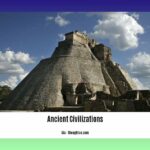Ancient History Meets Modern Memes: Unpacking the Bronze Age Collapse
Ever heard of Bronze Age Collapse Memes? Believe it or not, they’re a thing! These memes take a surprisingly humorous approach to a serious historical event – the downfall of powerful empires and the enigmatic disappearance of entire civilizations thousands of years ago. They use ancient artifacts, stories, and even complaints from millennia ago to craft jokes that are both relatable and absurd. Let’s dive into the world of Bronze Age Collapse Memes, explore their comedic appeal, and uncover what they reveal about how we view our own world today.
Picture this: the Bronze Age, a time of impressive empires, gleaming bronze weaponry, and surprisingly advanced societies. Then, imagine it all vanishing seemingly overnight. That’s the Bronze Age collapse in a nutshell, and its mysterious downfall has become a treasure trove of memes that are as thought-provoking as they are funny.
The internet, it seems, has a penchant for disaster, especially when it unfolded centuries ago. The Bronze Age collapse, with its shroud of mystery and dramatic demise of multiple civilizations, is like a historical car crash we can’t look away from.
One of the biggest mysteries? The Sea Peoples. These enigmatic figures were like the ultimate party crashers, appearing out of thin air and wreaking havoc on everyone. Were they pirates? Refugees fleeing some unknown catastrophe? Historians are still debating their true nature. Whatever their deal was, the Sea Peoples have become the poster children for the Bronze Age collapse, popping up in memes as the ultimate symbol of chaos and destruction.
But it’s not just about the Sea Peoples. The collapse also resulted in the loss of invaluable knowledge and skills, like writing systems and techniques for working with metal. Imagine losing all your hard drives and textbooks at once – yeah, it was kind of like that. So, naturally, people create memes lamenting the loss of this ancient wisdom, often with a dash of “if only they had Google Drive back then” humor.
Why Are We Laughing? The Allure of Dark Humor
The beauty of these memes lies in their ability to make you think while you’re chuckling. They highlight the fragility of civilizations, even the mighty ones. Let’s face it, sometimes you need a good laugh when contemplating the potential downfall of society. Plus, they make history accessible and engaging for people who might not otherwise give it a second thought.
So, the next time you come across a Bronze Age Collapse meme, take a moment to appreciate the sheer absurdity of it all. It’s a reminder that history is full of surprises, even hilarious ones, and that even the most advanced societies can crumble. It makes you wonder, what will future generations be meme-ing about us? Hopefully not our own societal collapse, but hey, stranger things have happened.
The Domino Effect: Why Was the Bronze Age Collapse So Devastating?
Imagine a world where once-mighty empires crumble, trade routes vanish, and entire civilizations collapse. That’s the stark reality of the Bronze Age Collapse, a period of widespread societal upheaval that began around 1200 BC. This catastrophic event, impacting civilizations across the Near East, Europe, and the Mediterranean, wasn’t the result of a single catastrophe, but rather a perfect storm of interconnected crises.
A Cascade of Catastrophes:
- Climate Change: Evidence suggests a severe drought, possibly lasting for generations, gripped the region around 1200 BC. This climate shift would have had devastating effects on agriculture, leading to widespread famine and social unrest.
- Economic Collapse: The Bronze Age world was built on a complex web of trade routes. As climate change and conflict disrupted these networks, essential goods became scarce, and economies crumbled.
- Internal Unrest: With resources dwindling and populations struggling to survive, empires faced mounting internal pressures. Rebellions, civil wars, and power struggles likely weakened these civilizations from within, making them vulnerable to external threats.
- The Enigmatic “Sea Peoples”: Adding fuel to the fire were the “Sea Peoples” – mysterious groups of seafaring raiders who launched attacks throughout the Mediterranean. While their origins and motives remain shrouded in mystery, their impact was undeniable. Coastal cities were sacked, trade routes were further disrupted, and fear spread throughout the region.
The Domino Effect:
The Bronze Age Collapse wasn’t a sudden catastrophe but rather a gradual unraveling of interconnected systems. The initial shocks, such as climate change and economic disruption, likely weakened the foundations of these civilizations. Internal strife further eroded their resilience, leaving them ill-prepared to withstand external threats like the Sea Peoples.
The End of an Era:
The Bronze Age Collapse wasn’t just a blip in history – it was a pivotal turning point. It marked the end of a period of great innovation and cultural exchange, ushering in a new era – the Iron Age. The collapse serves as a stark reminder of the interconnectedness of human societies and the fragility of even the most advanced civilizations. By studying this period, we can gain insights into the complexities of societal collapse and perhaps glean valuable lessons for navigating the challenges of our own time.
Picking Up the Pieces: How Long Did Recovery Take?
The Bronze Age, a period of remarkable technological innovation and cultural exchange, flourished for centuries. However, around 1200 B.C., this interconnected world began to unravel, leaving behind only fragmented memories of once-powerful empires. While pinpointing the exact start and end of the Bronze Age Collapse is challenging, determining how long it took for societies to recover is even more complex.
A Gradual Decline or a Sudden Collapse?
Some historians believe the collapse was a slow burn, a gradual process spanning generations. They see it as a series of unfortunate events, like dominoes toppling over time, gradually eroding the foundations of these civilizations. Others argue for a more abrupt end, a perfect storm of invasions, droughts, or cataclysmic climate shifts that shook these societies to their core.
The Long Road to Recovery:
Evidence suggests that it wasn’t until around 800 B.C. that areas around the eastern Mediterranean began to show signs of renewed vitality. This period saw the rise of new powers like the Phoenicians and the Greeks, who established new trade routes and cultural centers. However, many regions never truly recovered to their former glory. The aftershocks of the Bronze Age collapse reverberated for centuries.
Lessons in Resilience and Impermanence:
The Bronze Age Collapse serves as a powerful reminder of the cyclical nature of civilizations. It challenges our assumptions about progress and permanence, highlighting the delicate balance between human societies and their environments. It compels us to consider what factors might contribute to the collapse of our own civilizations and how we can foster resilience and adaptability in the face of uncertainty. While the Bronze Age Collapse may be shrouded in mystery, its lessons resonate through time, offering valuable insights into the human condition.
A Beacon in the Storm: Why Did Egypt Survive the Bronze Age Collapse?
As the Late Bronze Age crumbled around them, with empires falling and chaos reigning, ancient Egypt stood strong. They didn’t just survive; they clung to their culture, their power, and their identity. What was their secret? How did they weather the storm that swept away so many other civilizations?
Geographic Blessings:
- The Gift of the Nile: The Nile River was Egypt’s lifeline, providing a consistent source of water and fertile land for agriculture, even when droughts ravaged surrounding regions. This ensured a relatively stable food supply, a crucial advantage in times of widespread famine.
- Natural Barriers: The unforgiving deserts to the east and west, along with the Mediterranean Sea to the north, acted as natural shields, making it difficult for invaders to reach the heartland of Egypt. This natural protection provided a buffer zone other civilizations lacked.
Strength in Unity:
- Centralized Power: Unlike the fragmented city-states of other regions, Egypt benefited from a strong, centralized government headed by a powerful pharaoh. This centralized power structure allowed for swift decision-making, efficient resource allocation, and a unified response to threats.
- Military Might: The Egyptians had a formidable military force, well-equipped and well-trained. When the fearsome Sea Peoples set their sights on Egypt, Ramesses III and his armies were ready. They repelled the invaders, securing their borders and demonstrating their military prowess.
Adaptive Brilliance:
- Learning from Enemies: The Egyptians weren’t just content with defending their territory; they learned from their adversaries. They incorporated some of the Sea Peoples into their own forces, adopting their weapons, tactics, and shipbuilding techniques.
Beyond Geography and Governance:
While geographic advantages and a strong centralized government played significant roles in Egypt’s survival, some scholars believe other factors contributed to their resilience. They point to the strength of Egyptian cultural identity, their shared history, and their religious beliefs as unifying forces that helped them weather the storms of the Late Bronze Age Collapse.
A Nuanced Perspective:
It’s important to note that Egypt’s survival wasn’t without its challenges. They, too, faced internal strife, economic hardships, and political instability during this period. The Late Bronze Age Collapse marked a turning point for Egypt, leading to a decline in their power and influence. However, their ability to adapt, innovate, and maintain a sense of unity allowed them to weather the storm in ways that their neighbors could not.
A Mirror to the Present: What Lessons Can We Learn from the Bronze Age Collapse?
The Bronze Age Collapse, a defining period of upheaval that brought down powerful civilizations around 1200 BC, holds valuable lessons for us today. It’s not simply ancient history; it’s a stark reminder of the fragility of even the most advanced societies and the importance of understanding the interconnected nature of our world.
The Perils of Interdependence:
The Bronze Age was a time of remarkable interconnection. Vast trade networks facilitated the exchange of goods, ideas, and culture across vast distances. However, this interdependence also created vulnerabilities. Disruptions in one part of the network, whether caused by climate change, conflict, or other factors, could ripple outwards, impacting distant regions and contributing to systemic collapse.
- Relevance for Today: In our increasingly globalized world, we are more interconnected than ever before. Supply chains crisscross the globe, and events on one continent can have significant impacts on others. The Bronze Age reminds us to consider the potential risks associated with interdependence and to develop strategies for building resilience and redundancy into our systems.
The Limits of Resources:
While the exact role of resource depletion in the Bronze Age Collapse is still debated, it’s clear that overexploitation of essential resources can have severe consequences.
- Lessons for the Present: As we grapple with the challenges of climate change, resource scarcity, and a growing global population, the Bronze Age serves as a cautionary tale. Sustainable practices, responsible resource management, and a shift towards renewable resources are essential for avoiding the pitfalls of our ancestors.
The Importance of Adaptability:
While the Bronze Age Collapse was a period of widespread disruption and decline, it also showcased the remarkable resilience of human societies. From the ashes of collapsed empires, new civilizations emerged, adopting new technologies, developing innovative social structures, and adapting to the changing world.
- Hope for the Future: The Bronze Age reminds us that even in the face of seemingly insurmountable challenges, humanity is capable of adaptation and innovation. By embracing flexibility, fostering creativity, and learning from the mistakes of the past, we can navigate the uncertainties of the future.
The Importance of Leadership
The Bronze Age Collapse underscores the crucial role of strong and effective leadership, especially during times of crisis. Leaders who can anticipate challenges, adapt to changing circumstances, and guide their people through difficult times can be the difference between survival and collapse.
The Enduring Power of Knowledge:
One of the most tragic aspects of the Bronze Age Collapse was the loss of knowledge. With the decline of literacy and the collapse of centralized institutions, skills, technologies, and cultural practices were forgotten.
- A Reminder for Our Time: The preservation of knowledge, the importance of education, and the transmission of cultural heritage are vital for the long-term stability and prosperity of any society.
The Bronze Age Collapse is more than a historical curiosity; it’s a mirror reflecting our own vulnerabilities and potential. By learning from the mistakes of the past, by understanding the interconnected nature of our world, and by embracing adaptability and resilience, we can strive to create a more sustainable and equitable future.













1 thought on “Sea Peoples and System Errors: Deciphering the Dark Humor of Bronze Age Collapse Memes”
Comments are closed.